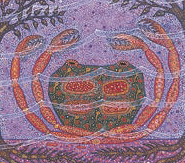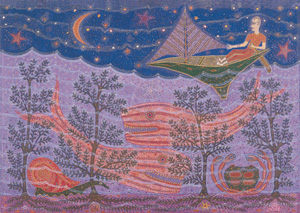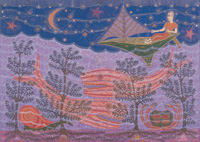 In the beginning, every voyage
starts with one step, or visual impulse, or precipitating
event. And so it was with my own personal Voyage, and
adventure of painting a picture by that name. In the beginning, every voyage
starts with one step, or visual impulse, or precipitating
event. And so it was with my own personal Voyage, and
adventure of painting a picture by that name.
  It
all began in Berkeley, many years ago I was waiting to
catch a train to San Francisco A friend, passing by,
greeted me; and just before I caught the train he handed me
a book which I had never seen before. It was a dog-eared
paperback, a copy of the Bhagavad-Gita, or Hindu Song of
God. Curious and interested, I began to read. And, as the
train started up, I realized that the book was taking me
on a completely different destination than to San
Francisco!. Because this was a journey -- or a true voyage
of a different color! And my mind began to fill up with
forms of such a journey done into a painting. And all the
thoughts I had ever had on this subject came into the
imagination of the inner eye vividly. First, there was the
ordinary "trip" to get to San Francisco. And then there
was the night-sea journey; then the fearsome journey to the
end of the night; then the impossible journey against all
odds to get to God knows where. And last, but not least,
the summary Voyage of no return. And I remembered
reading about exactly such a journey by a Sufi Saint, a
l0th-century Egyptian called Mohammed Al-Niffari. It
all began in Berkeley, many years ago I was waiting to
catch a train to San Francisco A friend, passing by,
greeted me; and just before I caught the train he handed me
a book which I had never seen before. It was a dog-eared
paperback, a copy of the Bhagavad-Gita, or Hindu Song of
God. Curious and interested, I began to read. And, as the
train started up, I realized that the book was taking me
on a completely different destination than to San
Francisco!. Because this was a journey -- or a true voyage
of a different color! And my mind began to fill up with
forms of such a journey done into a painting. And all the
thoughts I had ever had on this subject came into the
imagination of the inner eye vividly. First, there was the
ordinary "trip" to get to San Francisco. And then there
was the night-sea journey; then the fearsome journey to the
end of the night; then the impossible journey against all
odds to get to God knows where. And last, but not least,
the summary Voyage of no return. And I remembered
reading about exactly such a journey by a Sufi Saint, a
l0th-century Egyptian called Mohammed Al-Niffari.
How did I get to al-Niffari, of all people?
Only because voyages are only begotten by other voyages.
It's like an interlocking puzzle of endless beginning and
always new endings. Basically, first I had to meet Aldous Huxley, the
author-mentor of my youth. But before I could do that I
had to find the man who would truly open me to spiritual
life's beginning. And I couldn't do that until I found a
book. Which book, and where to find it? It was, as a
matter of fact, lying on a table at a friend's house.
It was by one Jiddu Krishnamurti. (More about my meetings
with Aldous Huxley, Christopher Isherwood, and Krishnamurti here,
if you are curious.)
So when I got home I looked up the
book and read again his visionary words:1
 God made me behold the sea, and I saw the
ships sinking, and the planks floating; then the planks too were
submerged. And God said to me "Those who cast themselves into the sea,
take a risk." And He said further: "Those who voyage and take no risk
shall perish." And, further: "The surface of the sea is a gleam that
cannot be reached. And the bottom is a darkness impenetrable. And
between the two are great fishes, which are to be feared." God made me behold the sea, and I saw the
ships sinking, and the planks floating; then the planks too were
submerged. And God said to me "Those who cast themselves into the sea,
take a risk." And He said further: "Those who voyage and take no risk
shall perish." And, further: "The surface of the sea is a gleam that
cannot be reached. And the bottom is a darkness impenetrable. And
between the two are great fishes, which are to be feared."
And, as if with a stylus of fire, these words were inscribed indelibly
on my painter's eye.
 Then a few days later, while at work, all these strands of thought
and visual inspiration suddenly took form, and with great urgency I made a
detailed drawing of what had been presented to my inner vision. Then a few days later, while at work, all these strands of thought
and visual inspiration suddenly took form, and with great urgency I made a
detailed drawing of what had been presented to my inner vision.
  When this drawing was finished, I made it into a small painting. But,
unfortunately, soon afterward the painting was stolen, and I was unable to
retrieve it.
When this drawing was finished, I made it into a small painting. But,
unfortunately, soon afterward the painting was stolen, and I was unable to
retrieve it.
 Unwittingly, however, the thief had done me
a great service. For then, with much painstaking work, I had to
completely recreate and substantially improve the lost painting. But, as
I proceeded, I quickly became very uncomfortable: For I realized that if
I pushed ahead with this project, I would be entering into completely
unfamiliar territory from which there could be no return, nor any
guarantee of safe arrival anywhere. Then I realized with an intuitive
flash of comprehension that painting, like any other truly worthwhile
enterprise, or a true Voyage, was exceedingly dangerous, a great
risk -- a real trip into the unknown, with no assurance of safe arrival at
journey's end, and no guarantee of any reward whatsoever; but then,
I remembered that old-time painters had done exactly that: Rather than
serving the ego, they painted for the greater glory of the Divine to
"make something beautiful for God." That would be their only Truth
and their true reward. Unwittingly, however, the thief had done me
a great service. For then, with much painstaking work, I had to
completely recreate and substantially improve the lost painting. But, as
I proceeded, I quickly became very uncomfortable: For I realized that if
I pushed ahead with this project, I would be entering into completely
unfamiliar territory from which there could be no return, nor any
guarantee of safe arrival anywhere. Then I realized with an intuitive
flash of comprehension that painting, like any other truly worthwhile
enterprise, or a true Voyage, was exceedingly dangerous, a great
risk -- a real trip into the unknown, with no assurance of safe arrival at
journey's end, and no guarantee of any reward whatsoever; but then,
I remembered that old-time painters had done exactly that: Rather than
serving the ego, they painted for the greater glory of the Divine to
"make something beautiful for God." That would be their only Truth
and their true reward.
  I felt
as if I had been given an archetypal vision to paint, and so I seized
the day, and set about bringing that vision into painted form. But about
that time, I discovered Adi Da Samraj's
The Knee of Listening", read it intensively,
and then wrote to the author, thanking Him "for a gift I could not yet
comprehend!" And soon got a letter back from the Ashram Manager saying:
Adi Da "has read your letter completely and He sends you His Blessing";
which moved me deeply. Still later, after I had been to Los Angeles
for an interview, I had the opportunity to meditate with Him. The sitting
was a revelation of His Compassion, and I saw His undefended purity,
and radiance of Being. I felt
as if I had been given an archetypal vision to paint, and so I seized
the day, and set about bringing that vision into painted form. But about
that time, I discovered Adi Da Samraj's
The Knee of Listening", read it intensively,
and then wrote to the author, thanking Him "for a gift I could not yet
comprehend!" And soon got a letter back from the Ashram Manager saying:
Adi Da "has read your letter completely and He sends you His Blessing";
which moved me deeply. Still later, after I had been to Los Angeles
for an interview, I had the opportunity to meditate with Him. The sitting
was a revelation of His Compassion, and I saw His undefended purity,
and radiance of Being.
 When I had finished the painting I knew it
was the best I had done or might do, and I must give it directly to Him
without delay. He received it most graciously, and, with many jests
(and much hilarious laughter!), asked me if I would put a wide-painted
frame around it and expand the very picture onto that frame. This being
done resulted in the current complete work, which is 78" x 56",
done in casein paint on a gesso panel. When I had finished the painting I knew it
was the best I had done or might do, and I must give it directly to Him
without delay. He received it most graciously, and, with many jests
(and much hilarious laughter!), asked me if I would put a wide-painted
frame around it and expand the very picture onto that frame. This being
done resulted in the current complete work, which is 78" x 56",
done in casein paint on a gesso panel.
More about a very special
art teacher, Henry Schaefer-Simmern, and the influence
he had on the making of The Voyage.
  Now, the above is not an "explanation" of The
Voyage, but only a few relevant facts about its inspiration and
genesis. Because if a painting could ever be "explained," then it need
never be painted at all. And so I hope these notes will help you to
share the "content" of The Voyage and
make it yours, if you so wish -- though none of this can be done with
words or analysis, but simply by looking. And, before you look, please
remember the unalterable truth that: "The Spirit that dwells in the forms
speaks only to him, or to her, who stands speechless in wonder!"
Now, the above is not an "explanation" of The
Voyage, but only a few relevant facts about its inspiration and
genesis. Because if a painting could ever be "explained," then it need
never be painted at all. And so I hope these notes will help you to
share the "content" of The Voyage and
make it yours, if you so wish -- though none of this can be done with
words or analysis, but simply by looking. And, before you look, please
remember the unalterable truth that: "The Spirit that dwells in the forms
speaks only to him, or to her, who stands speechless in wonder!"
 And I hope that your Voyage (and perhaps
mine too!) will lead only to Light, beyond all categories of mere formal
beauty! And I hope that your Voyage (and perhaps
mine too!) will lead only to Light, beyond all categories of mere formal
beauty!
Sincerely,
Kerwin Whitnah
|





 In the beginning, every voyage
starts with one step, or visual impulse, or precipitating
event. And so it was with my own personal Voyage, and
adventure of painting a picture by that name.
In the beginning, every voyage
starts with one step, or visual impulse, or precipitating
event. And so it was with my own personal Voyage, and
adventure of painting a picture by that name.
 Now, the above is not an "explanation" of The
Voyage, but only a few relevant facts about its inspiration and
genesis. Because if a painting could ever be "explained," then it need
never be painted at all. And so I hope these notes will help you to
share the "content" of The Voyage and
make it yours, if you so wish -- though none of this can be done with
words or analysis, but simply by looking. And, before you look, please
remember the unalterable truth that: "The Spirit that dwells in the forms
speaks only to him, or to her, who stands speechless in wonder!"
Now, the above is not an "explanation" of The
Voyage, but only a few relevant facts about its inspiration and
genesis. Because if a painting could ever be "explained," then it need
never be painted at all. And so I hope these notes will help you to
share the "content" of The Voyage and
make it yours, if you so wish -- though none of this can be done with
words or analysis, but simply by looking. And, before you look, please
remember the unalterable truth that: "The Spirit that dwells in the forms
speaks only to him, or to her, who stands speechless in wonder!"




